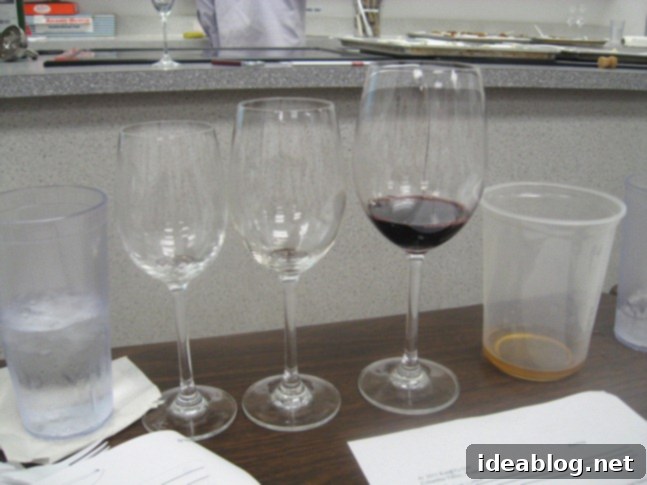Mastering Advanced Culinary Arts: A Week of Precision, Butchery, and Fine Dining Prep
This past week at culinary school has been an exhilarating and demanding journey, meticulously preparing us for our upcoming practical exam. Each day presented us with time-intensive menus, pushing our skills and efficiency to their limits. The kitchens were a whirlwind of focused energy, as every student hustled to execute complex dishes with precision and deliver them on schedule, simulating the high-pressure environment of a professional kitchen.
Wednesday’s first course, in particular, stood out as an exceptionally challenging and rewarding experience. We embarked on the creation of a sophisticated squab timbale. For those unfamiliar, a timbale is essentially a molded dish, showcasing a chef’s ability to create both flavor and visual artistry. This particular iteration was an elaborate construction: a delicate mold of squab meat, intricately wrapped in tender, braised endive leaves, and generously filled with a medley of other savory components. It marked our inaugural encounter with squab—more commonly known as pigeon meat—in a professional setting, a true test of our advanced poultry preparation skills.
Fair warning to the squeamish: the following section details the intricate butchery process of squab. If you prefer to skip these details, feel free to scroll down to the culinary assembly of the timbale!
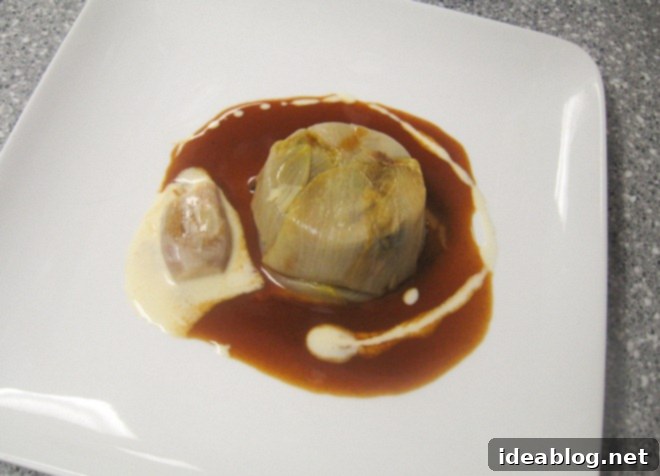
The journey to crafting our squab timbale commenced with the foundational task of breaking down whole pigeons. Unlike the more common poultry we’d previously handled, we received the entire bird—head, feet, internal organs, and all. This presented a unique challenge, requiring us to perform a complete and meticulous cleaning and preparation. While the initial sight might sound a tad unsettling, I found the process incredibly fascinating, akin to a hands-on culinary dissection. It offered an unparalleled insight into the anatomy of the bird and the delicate art of advanced butchery. It was undeniably a solemn experience, handling the whole animal, but an essential lesson in respecting the ingredients we work with. The process began by carefully removing the head and legs, followed by using our hands to precisely detach the lungs from the rib cage. This was a rather messy and intricate step, demanding both dexterity and a keen understanding of anatomy. Once the lungs were freed, we were then able to swiftly and cleanly remove the remaining internal organs in a single, fluid motion, a testament to efficiency learned through practice.
After the birds were thoroughly cleaned and prepped, we expertly trussed them, preparing them for the initial cooking stages. The legs and back were first seared over high heat on the stovetop, developing a rich, caramelized crust and locking in flavors. Following this, the entire pigeon was transferred to the oven for a precise roasting, ensuring even cooking and tender meat, forming the flavorful core of our timbale.
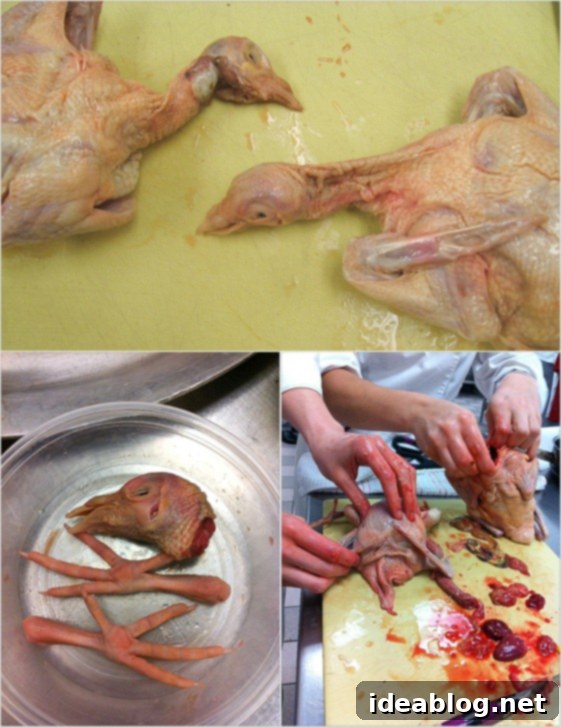
While our pigeons roasted to perfection, the kitchen simultaneously buzzed with the assembly of the remaining timbale components. We had commenced braising the endive leaves first thing that morning upon arrival at school, allowing them ample time to become incredibly tender and infuse with aromatic flavors. Other integral fillings included perfectly sautéed mushrooms, adding an earthy depth, and small, exquisitely seared portions of foie gras (duck liver), contributing a luxurious richness and silky texture. We also made sure to utilize the delicate livers of the pigeon itself, showcasing a nose-to-tail approach to cooking. To bind all these magnificent ingredients together, we were provided with a superb veal mousse, masterfully prepared by Chef Patrice during his morning lecture. This mousse served not only as a binder but also added another layer of subtle, savory complexity to the dish.
Once the roasted pigeon reached its optimal doneness, we carefully removed the breasts and legs, allowing the meat to rest briefly before thinly slicing it. The final assembly of the timbale was a delicate operation: ramekins were meticulously lined with the tender braised endive leaves, creating an elegant outer shell. These lined molds were then carefully filled with our flavorful mixture of sliced pigeon meat, foie gras, sautéed mushrooms, and pigeon livers, all bound by the veal mousse. The filled ramekins were then placed in a water bath and gently baked at a low temperature for approximately 30 minutes. This low-and-slow cooking method in a water bath ensures even heat distribution, preventing the delicate timbale from drying out and allowing it to set beautifully, resulting in a supremely tender and cohesive structure.
To complement the richness of our squab timbale, we meticulously prepared an exquisite orange gastrique. A gastrique is a classic French culinary technique involving caramelizing sugar and then deglazing it with an acidic component, typically red wine vinegar, resulting in a perfectly balanced sweet-sour sauce. We further elevated this gastrique by incorporating it into a rich jus, which we painstakingly prepared from the bones of the pigeon, extracting every last bit of savory flavor. Alongside this, we crafted a simple yet elegant shallot cream sauce, adding another layer of smooth, aromatic flavor to the plate. As you can likely infer, this entire dish was a monumental undertaking, demanding precision, patience, and a mastery of multiple complex techniques. Yet, the final tasting affirmed that every minute of effort was well worth it—the flavors were harmonious and utterly delicious!
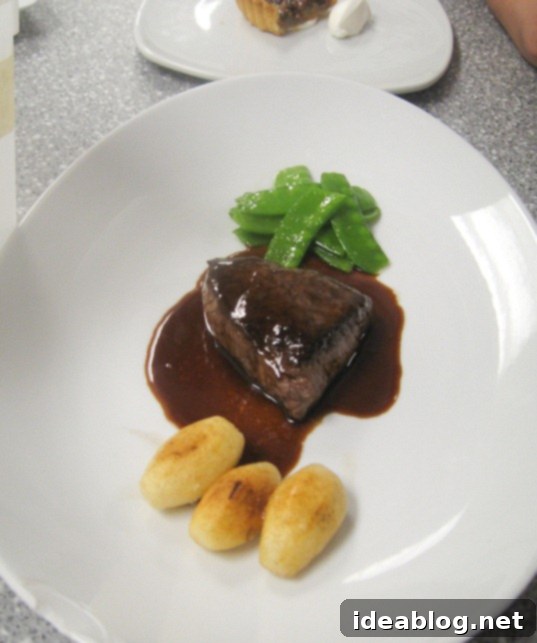
Thankfully, to provide a counterbalance to the labor-intensive first course, our main course was designed to be a simpler, yet equally refined, affair: a classic steak poele. This involves expertly pan-searing a high-quality cut of steak to a perfect medium-rare, developing a beautiful crust while keeping the interior juicy and tender. It was served alongside a luxurious Bordelaise sauce, a hallmark of French cuisine known for its deep, rich flavor derived from red wine, shallots, and bone marrow. For accompaniments, we sautéed crisp snap peas, providing a fresh, vibrant contrast to the rich meat and sauce. We also revisited a familiar, yet challenging, potato dish from Phase I: pommes rissolees. This intricate preparation involves first “tourneeing” potatoes—a demanding technique where potatoes are uniformly carved into elegant, barrel-shaped pieces, requiring extreme precision and consistency. These tourneed potatoes are then quickly blanched to soften them slightly before being sautéed to a golden perfection in clarified butter. The uniform shape not only ensures even cooking but also adds a touch of elegance to the presentation. With time rapidly dwindling, I found myself tourneeing the potatoes at an unprecedented speed during service, a true test of nerve and honed knife skills under pressure!
To conclude our elaborate meal, we prepared a delightful pecan tart for dessert, presented with an elegantly scooped quenelle of freshly whipped cream. The tart featured a flaky, tender pate brisee crust, a classic sugar-free dough known for its buttery richness and delicate texture, providing the perfect foundation for the sweet filling. The filling itself was a luscious mixture of melted butter, granular sugar, golden maple syrup, light corn syrup, fragrant toasted pecans, and a single egg, all combined to create a rich, sweet, and nutty custard that set beautifully. Immediately upon emerging from the oven, while still warm, the tart was generously brushed with a tantalizing mixture of Kentucky bourbon and vanilla extract. This final touch infused the tart with an aromatic warmth and a subtle depth of flavor, making each bite an absolute delight. The combination of the crisp crust, gooey, nutty filling, and the hint of bourbon created a truly memorable dessert.
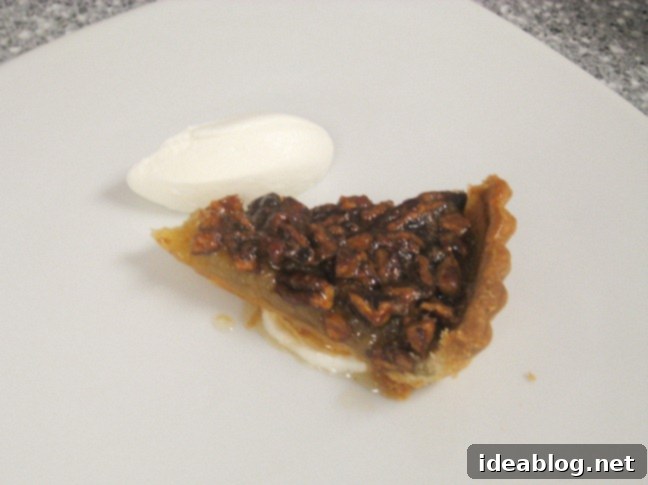
We capped off this incredibly exhausting yet fulfilling day with our third, and final, wine class of the program. This session was particularly insightful, delving deeper into the fascinating world of food pairing—understanding how different wines can enhance or complement various culinary creations. We had the distinct pleasure of tasting a diverse selection of wines, carefully chosen to illustrate different varietals and regions. The tasting also included exquisite Champagne, specifically Perrier-Jouet, a truly high-quality sparkling wine that exemplifies the finest in viticulture. Beyond the traditional wines, we explored the rich complexities of a very good quality Madeira and Port, both fortified wines known for their unique aging processes and profound flavor profiles. The class was not just about tasting; it was an educational journey into appreciating the nuances of each pour.
I suspect that the intensity of the day’s practical cooking, combined with the rigorous wine tasting, meant most of us hadn’t consumed enough lunch. By the end of the class, a collective goofiness had certainly set in among the students, a testament to the combined effects of fatigue and a generous sampling of fine beverages. Our spit cups, usually a diligent repository, were suspiciously on the empty side, suggesting a more enthusiastic approach to the tasting than perhaps intended!
After the jovial atmosphere of the wine class, I headed home with a singular, albeit challenging, mission: to concentrate on studying for our theory exam scheduled for the very next day. Focusing after such a comprehensive and stimulating day, especially following a wine tasting, was certainly a test of mental fortitude, but a necessary step towards mastering our culinary curriculum.
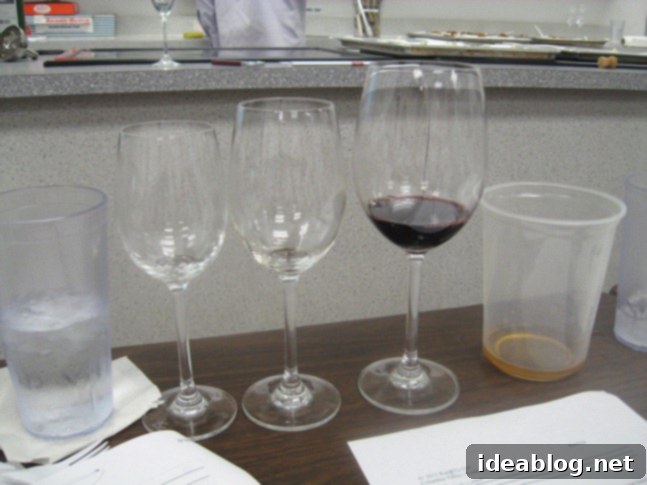
I’ll be back soon with an update detailing Thursday’s intensive class, as well as the outcome and reflections from today’s significant fifth practical exam. The journey through advanced culinary arts continues, bringing new challenges and invaluable learning experiences with every passing day.
